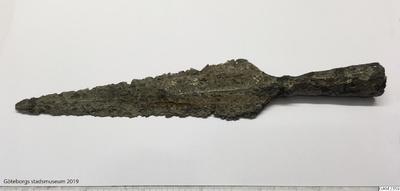| Typ <itemType> |
Objekt/föremål |
| Datering <presTimeLabel> |
1892 |
| Plats <presPlaceLabel> |
Västmanland, Östervåla, Våla |
| Beskrivning <itemDescription> |
-
Basic measurements:
Weight: 401 g
Total length: 353 mm
Total width: 62 mm
Socket diameter: 32 mm
Blade thickness at the shoulders: 10.5 mm
Length of the blade: 258mm
Length of the edged portion of the blade: 230 mm
Point of balance: about 140 mm from the end of the socket.
|
| Beskrivning <itemDescription> |
|
| Beskrivning/description / english <itemDescription> |
-
Petersen Type H spearhead, with a pattern-welded core including a wolf-tooth pattern. Wolf-tooth patterns seem to be rare, and mostly found in Petersen Type K and M spears (with also some occurrences ...
Visa hela
Petersen Type H spearhead, with a pattern-welded core including a wolf-tooth pattern. Wolf-tooth patterns seem to be rare, and mostly found in Petersen Type K and M spears (with also some occurrences of Type D, G or H). These are apparently only "local", Scandinavian designs, not imported, Frankish ones.
Stäng
|
| Beskrivning/description / english <itemDescription> |
-
Comments on the construction of the spearhead:
The conical socket was attached to the spear shaft by means of two nails, one of which survives, the other one left a hole 4 mm in diameter. The nails ar...
Visa hela
Comments on the construction of the spearhead:
The conical socket was attached to the spear shaft by means of two nails, one of which survives, the other one left a hole 4 mm in diameter. The nails are aligned with the blade. The socket was made out of a sheet of iron welded along a line in a plane roughly perpendicular to the holes. No visible decorations are left on the socket. The socket walls are at least 2.1-2.4 mm thick, but it is possible that they are thicker: the pitting is deep in places but no holes are visible. It is possible that the socket was usually polygonal (octagonal?) as it seems to present in places flat-ish surfaces, but the state of the metal makes it difficult to judge whether this was the original shape, or a result of corrosion/conservation. A polygonal socket would be quite exceptional for a Type H spearhead. A bulge, typical of Type H spears, is visible at the junction between the socket and the blade. The hollow inside the socket is 95 mm deep. This is exactly the length of the socket plus the bulge, so the weld attaching the socket to the blade is presumable either in the bulge (hidden under it?), or after it. Deep lines run just after the bulge but these might be a result of conservation work rather than signs of the welding line.
The blade has a composite construction, made of 7 different elements of metal (possibly only 4 if all the outer elements are bent around rather than made of two pieces). The core, of layered (folded) iron, is 10-12 mm wide, and about 12 cm long (from the base of the blade) - it extends about 9 cm further than the shoulder of the blade. The second layer, 30 mm wide at the shoulder of the blade, is made of twisted pattern-welded rods. The direction of the twist is the same on both sides of the blade, rather than symmetric. The number of layers in the twisted rods was not determined, and the surface preservation near the base of the blade made it impossible to say whether the end of this layer was forged to shape or ground. The third layer is a wolf-tooth pattern, of homogeneous metal. The toothed bands are about 5 mm thick, and the teeth are about 3 mm high and spaced by 5 mm. The last layer is the edge, of layered (folded) metal, presumably steel rather than iron. The lines of the metal, flowing around the wolf-tooth pattern, show clearly that the edge was forged onto the pre-formed teeth (rather than a iron rod being forged onto teeth pre-formed in the steel band). The layered edge shows signs of delamination in several places. The cutting edge itself is preserved nowhere, and the remaining, corroded edge is damaged (bent) in several places, but it is impossible to know whether this damage precedes the corrosion process or not. The blade has a simple diamond cross-section, with simple bevels. The ridge is offset by about 1 mm from the middle of the spearhead on all its length (save for the tip), but is well-aligned with the socket. While such an asymmetry is far from abnormal, it is possible (given the shape of the blade and the corrosion state of the edges) that one edge is more corroded than the other. The blade is slightly bent (with an offset of 7 mm with respect to a perfectly straight line), the bend starts about 9 cm from the tip of the blade. Again it is impossible to tell whether this happened before or after deposition - although a bend happening during the use of the weapon might have rather happened closer to the point./Dr Jan Orkisz 2019-12-02
Stäng
|
| Inventarienummer <itemDescription> |
|
| Utställning / utställd i <itemDescription> |
|
| Förvärvsomständigheter / till museet <itemDescription> |
|
| Namn / copyright/upphovsrättsinnehavare <itemDescription> |
|
| Licens / media <itemDescription> |
|
| Händelse <context> |
-
Brukad .
-
Förvärvad 1892 i Våla, Östervåla, Västmanland.
|
| Materialkategori<itemMaterial> |
- metall
|
| Material<itemMaterial> |
- järn
|
| Mått <itemMeasurement> |
-
Längd: 35,3
-
Bredd: 6,2
-
Diameter: 3,2 sockel
|
| Sakord<itemName> |
- spjut
- jaktvapen
- typ h [petersen typ h]
|
| Ämne <subject> |
|
| Inventarienummer <itemNumber> |
|
| Rättigheter för metadata <itemLicense> |

|
| Källa <presOrganization> |
Göteborgs stadsmuseum |
|
Källa <url>
|
|




 ARTIKLAR I WIKIPEDIA
ARTIKLAR I WIKIPEDIA ARTIKLAR I WIKIDATA
ARTIKLAR I WIKIDATA BILDER I WIKIMEDIA COMMONS
BILDER I WIKIMEDIA COMMONS



